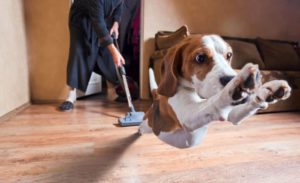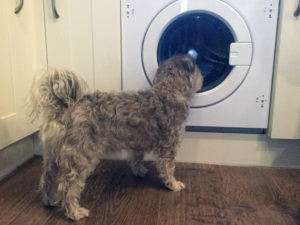Fear of Noises – using classical conditioning
 Dogs and their fear of noises
Dogs and their fear of noises
With fear of noises – using classical conditioning is quite useful, especially when a noisy event is regularly frightening your dog. One of our dogs Bandit is very sensitive to noise. Any noise will get him barking and it is a problem we have to concentrate on every day. He is getting better but last week, we had an extra problem. We purchased a new washing machine.
The spin din!
The machine itself didn’t worry him one jot, it was the fearful noise it made once it started to spin. He was so frightened, he ran off into another room. At this time of year, with every walk ending in the showering of both dogs, towels are continually having to be washed. But as we all know, towels and washing machines often mean thumping noises as the machine is often out of balance.
Start slow
 I started with a non towel wash. Once it started to spin I gave both dogs a treat in the lounge area. Bandit was a little reluctant to take the treat which gave a clue to his level of fear. At each spin, they were both rewarded.
I started with a non towel wash. Once it started to spin I gave both dogs a treat in the lounge area. Bandit was a little reluctant to take the treat which gave a clue to his level of fear. At each spin, they were both rewarded.
Next I progressed to bringing both dogs to the machine just before it started to spin. Jazz didn’t have a problem with the machine whether it was spinning or not, but he needed to be included in the exercise. Being laid back about the washing machine would help convince Bandit there was no threat. It probably helped because Bandit wasn’t too bad at a normal spin and did take the treat.
Then up the anti
Now was the time for a towel wash. Once the machine started its spin, I showed the dogs a tasty bit of sausage in the lounge, waving it around so they could smell it. The machine, on queue, started its unbalanced banging and Bandit looked worried but was still interested in the sausage I was waving around. He took it slowly whilst looking in the direction of the noise. Mind you, the machine was making quite a din so I rewarded him with extra sausage.
Be calm at all times
Would he now stay in the kitchen when the spin started up. I called them both into the kitchen, Jazz came straight away. Bandit reluctantly looked around the corner but did slowly come towards the washing machine. Once it started its spin, I showed them both a large piece of sausage that was on offer. I knelt down with my back to the machine, showing Bandit I was not worried so why should he be. The machine was exceptionally noisy but still Bandit slowly took the sausage.

Success, Bandit relaxes
We stayed in the kitchen and Bandit started to relax despite the row the machine was making. I think it helped having Jazz there who was completely blasé about the noisy machine. The last spin goes on for quite a while so I took the opportunity of putting a piece of sausage actually on the lip of door of the machine. Jazz took it immediately so I put another piece on for Bandit.
By this time the machine was at full spin and was vibrating so much the sausage was moving. Bandit hesitated but when he saw Jazz make a move, he quickly snatched the sausage from off the door.
Great! I repeated the exercise a few times and now look at Bandit’s tail, right up and confident, watching the spinning towels and waiting for his reward for being so brave!
Remember!

Now the dogs come to me for a treat whenever the washing machine spins! Be very careful never to reward fearful or anxious behaviour. The reward is for being more relaxed, calmer and for an improvement in a behaviour. Remember, if you give affection when your dog is fearful, you will be rewarding that unwanted fearful behaviour. This could actually worsen his fear. Dogs do not think like humans. We as humans, get comfort from a bit of sympathy. But if your dog is in a fearful or unwanted state of mind and you reward him, he will think you are approving and agreeing with his state of mind!
The timing of rewarding
Rewarding at the right time is easier said than done. Just remember to reward something that is positive and going forward towards your goal. Timing is of the essence, if you’re not sure whether to reward or not just think if the behaviour he is showing right now is an improvement on the unwanted behaviour you are trying to eliminate. If it is, give a reward; this will hopefully encourage him to repeat the behaviour. For a substantial improvement, reward generously.
When the goal is achieved!
If the improvement is such that he has achieved your goal, throw the treat bag at him! (Please remember to reduce his food quota if rewards are substantial). Once the good behaviour is well established, it will become a habit and you can reduce or eliminate the treats. I always have yummy treats on board, just in case my dogs do something really amazing and I can let them know how pleased I am with them.
